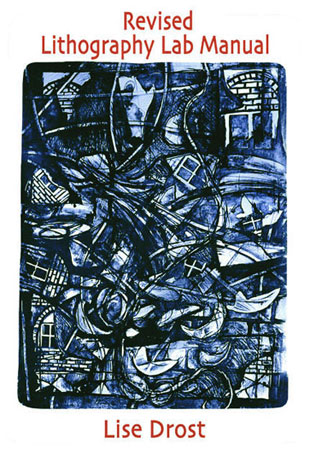
 |
email: LiseDrost@aol.com




The traditional surface for lithography is Bavarian limestone which needs to be regrained by hand for each use. The premise is simple: oil based printing ink and water will repel each other. The image is drawn with greasy crayons and pencils, and chemically treated so the image areas of the stone or plate will accept ink and the undrawn areas will reject it. Maintaining the balance between these two fragile stencils can be enormously difficult. The exact tonalities of the image can be easily ruined by the application of the wrong chemical or ink. Despite its unforgiving nature, lithography is tempting to artists because it is so autographic: it can faithfully reproduce any mark, texture or gesture the artist can make. Good black and white lithographs have the sensitivity of actual drawings; good color work can have rich layered effects that can’t be achieved with drawing or painting. And in the hands of a good printer, either can be made in endless multiples, an important factor for many artists interested in making “multiple-originals” of their work. Other printmaking processes such as etching and woodcut have the reputation for being indirect, requiring multiple steps and considerable skill to even put an image onto a plate or block before printing begins. But in lithography the drawing of the image is quite direct. The problems arise in the processing and printing, historically prompting artists to collaborate with Master Printers who would take over the process once the image was put on the stone or plate. This system survives today in contract lithography shops all over the world. But I maintain that the best lithographs are made by artists who also know the process inside and out, who know the possibilities of the medium and more than the usual visual effects it can create.
This manual is for those artists who want to master the lithographic process. It is written for beginners but has enough information to be useful to those who are already skilled in this process. The format is a basic step by step approach from plate and stone preparation through signing and documentation of finished prints, with considerable emphasis on trouble shooting. Other books overlook the fact that beginning lithographers will make mistakes and usually don’t want to be told to just start over after investing time and energy and money into a project. In my twenty years of experience making lithographs and teaching printmaking I have seen a lot of peculiar printing problems which have led me to a greater understanding of the nuances of this medium: in fact, it is best understood through experiencing and solving problems. So my approach in the manual is not the safe approach advised by other books and nearly all contract printers: my goal is to help beginning lithographers use the medium to make what they need to see in their artwork rather than accepting what the medium will easily give them.
This new version includes information on photo lithography, transfer papers, and toner washes and transfers and replaces both The Lab Manual of Aluminum Plate Lithography (1987) and Stone and Plate Lithography Lab Manual (1991). Its currently available from Graphic Chemical and Ink Company, Rembrandt Graphic Arts, Renaissance Graphic Arts, and Takach Press Corporation.